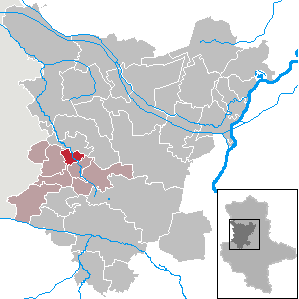Wefensleben
| coat of arms | Germany map | |
|---|---|---|

|
Coordinates: 52 ° 11 ' N , 11 ° 10' E |
|
| Basic data | ||
| State : | Saxony-Anhalt | |
| County : | Börde | |
| Association municipality : | Upper all | |
| Height : | 123 m above sea level NHN | |
| Area : | 12.63 km 2 | |
| Residents: | 1705 (Dec. 31, 2019) | |
| Population density : | 135 inhabitants per km 2 | |
| Postal code : | 39365 | |
| Area code : | 039400 | |
| License plate : | BK , BÖ, HDL, OC, OK, WMS, WZL | |
| Community key : | 15 0 83 535 | |
| Association administration address: | Zimmermannplatz 2 39365 Eilsleben |
|
| Website : | ||
| Mayoress : | Ulla Krolop | |
| Location of the municipality of Wefensleben in the Börde district | ||
Wefensleben is a municipality in the Börde district in Saxony-Anhalt (Germany). It belongs to the community of Obere Aller , which has its seat in the community of Eilsleben .
geography
Wefensleben is located on the Aller River , in the lowland between the foothills of the Lappwald and the Osterberg (166 m). In the west, a 24 hectare mixed forest with the name " Trenckmann 's Busch" or "Zechenholz" borders the place.
Community structure
The district of Belsdorf and the Zechenhaus residential area belong to Wefensleben .
history
Local history
The first documentary mention was made in 1160 in the inventory of the St. Ludgeri monastery in Helmstedt .
Until the middle of the 18th century, Wefensleben was a pure farming village. Existing mineral resources in the district influenced the development of the place. Coal mining began with the discovery of a coal seam in 1741. Up to 1825 coal was mined in up to 12 shafts. From 1809 the colliery was the seat of the "Ostfälische Berg- und Hüttenverwaltung", from 1815 - 1843 the "Berg- und Hüttenverwaltung des Administrative District Magdeburg". Between 1750 and 1900 sandstone was mined in three quarries. a. was used as building material for important sacred and secular buildings in central Germany . At the beginning of the 20th century, potash and salt were mined in Wefensleben. During this time, a factory for salt processing and two settlements were built.
In the 1970s, prefabricated buildings were built and Wefensleben became a place to sleep and live for the staff at the Marienborn border crossing point and their families. From 1978, high-quality clay from the south of the municipality was processed for brick production in a brick factory. After the fall of the Wall, the factory became part of the " Wienerberger brick industry", which expanded the factory into one of the most modern brick factories in Germany.
Incorporations
Belsdorf was incorporated on July 1, 1950 and is approx. 1 km from Wefensleben. The cloister courtyard was built here in 1327 as a result of medieval relationships with the Marienborn monastery . In the former cloister courtyard known as Hof Tangermann there is a baroque, octagonal pigeon tower from 1789.
Population development
The population has decreased drastically after the fall of the Wall . In addition to the general development in Germany, the main reason for the decline in population is the loss of jobs at the Marienborn border crossing.
|
(Sources: State Statistical Office Saxony-Anhalt)
religion
The Protestant church on the Hünenberg is the oldest surviving structure in the community. The oldest parts are from the 12th / 13th centuries. The nave is a new building from 1735, whereby the pulpit altar, the wooden barrel ceiling and the gallery are original. There is also a Protestant church in the Belsdorf district, the Belsdorf village church. It is a neo-Romanesque new building from 1867 with a simple interior, to which a tower was added in 1887, and stands in a former cemetery.
politics
coat of arms
The coat of arms was approved on April 13, 1992 by the Magdeburg Regional Council.
Blazon : “Square of red and silver; Field 2: a black tower with silver window and door openings and silver wall joints, field 3: crossed black hammer and mallet. "
The tower used represents the listed pigeon tower on the monastery estate in Belsdorf. This symbol is intended to characterize the togetherness of the district of Belsdorf with the village of Wefensleben as well as the agricultural character of the community. The miners toughness stands for the historical tradition of the community as a mining location. In the vicinity of the community there are still individual buildings, tunnels and embankments that are reminiscent of this tradition.
Memorials
- Memorial stone from 1978 in the school yard in Bahnhofstrasse in memory of the communist Spain fighter Hans Beimler , who died in 1936.
Culture and sights
The protected cultural monuments of the municipality are listed in the local register of monuments. The Glockenborn spring, located on the municipal border with Ummendorf, also belongs to the municipality .
Sports
- Multipurpose hall (gym) with bowling alley
- sports ground
- TSV Wefensleben 1990 eV
Economy and Infrastructure
traffic
Wefensleben is on the Braunschweig – Magdeburg railway line and has a direct railway connection. The L 40 provides a direct connection to the federal highway 245 , the federal highway 1 and the federal highway 2 .
Public facilities
- day care center
- Children's home
education
- School for the mentally handicapped
Personalities
- Andreas Friedrich Trenckmann (1809–1883), teacher and headmaster in Magdeburg, later farmer and president of the oldest agricultural association in Texas
Individual evidence
- ↑ State Statistical Office Saxony-Anhalt, population of the municipalities - as of December 31, 2019 (PDF) (update) ( help ).





